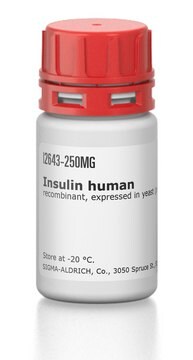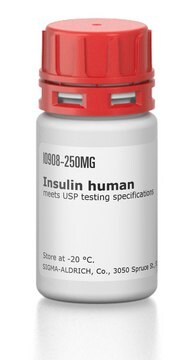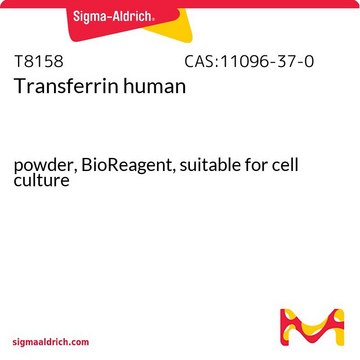11376497001
Roche
Insulin, human
recombinant (yeast)
Synonym(s):
Insulin human
Sign Into View Organizational & Contract Pricing
All Photos(1)
About This Item
Empirical Formula (Hill Notation):
C257H383N65O77S6
CAS Number:
Molecular Weight:
5807.57
MDL number:
UNSPSC Code:
12352200
form:
lyophilized (clear, colorless solution after reconstitution)
Assay:
>98% (SDS-PAGE)
Recommended Products
Quality Level
sterility
non-sterile; 0.2 μm filtered
Assay
>98% (SDS-PAGE)
form
lyophilized (clear, colorless solution after reconstitution)
mol wt
5,700 Da
packaging
pkg of 100 mg
manufacturer/tradename
Roche
technique(s)
cell culture | mammalian: suitable
impurities
<0.1 EU/μg endotoxin (LAL test)
solubility
water: soluble
UniProt accession no.
storage temp.
2-8°C
InChI key
PBGKTOXHQIOBKM-FHFVDXKLSA-N
Gene Information
human ... INS(3630)
Looking for similar products? Visit Product Comparison Guide
General description
At least the same specific activity (EC<sub>50</sub>) compared to the indicated standard is guaranteed.
Recombinant Insulin, human, is produced in yeast and purified by standard chromatographic techniques. Insulin regulates blood glucose. In muscles and adipocytes it stimulates glucose intake and metabolism. It also controls the expression and various enzymes.
Specificity
Insulin, human, is active on most mammalian cells.
Application
Insulin shows a broad range of activities on a variety of somatic cells. Recombinant human insulin can be used to stimulate growth and proliferation of cultured cells and to investigate insulin activity on sensitive cells used in research studies. It is also a component of serum-free media formulations for most primary cells and cell lines.
Biochem/physiol Actions
Two-chain polypeptide hormone produced by the β-cells of pancreatic islets. Its molecular weight is ~5800 Da. The α and β chains are joined by two interchain disulfide bonds. The α chain contains an intrachain disulfide bond. Insulin regulates the cellular uptake, utilization, and storage of glucose, amino acids, and fatty acids and inhibits the breakdown of glycogen, protein, and fat.
Other Notes
InChI: 1S/C257H383N65O77S6/c1-29-131(23)205(313-193(339)104-259)252(393)317-204(130(21)22)248(389)288-159(75-82-200(349)350)217(358)282-156(71-78-189(263)335)221(362)308-183-116-403-404-117-184-243(384)305-178(111-324)240(381)294-162(88-123(7)8)225(366)295-168(95-140-53-61-146(329)62-54-140)228(369)283-154(69-76-187(261)333)218(359)290-161(87-122(5)6)223(364)285-158(74-81-199(347)348)220(361)302-174(101-190(264)336)235(376)298-170(97-142-57-65-148(331)66-58-142)231(372)309-182(242(383)304-176(255(396)397)103-192(266)338)115-402-401-114-181(214(355)273-107-194(340)278-153(72-79-197(343)344)216(357)281-151(51-42-84-271-257(267)268)212(353)272-108-195(341)279-166(93-138-46-36-32-37-47-138)227(368)297-167(94-139-48-38-33-39-49-139)230(371)299-171(98-143-59-67-149(332)68-60-143)238(379)320-208(135(27)327)254(395)322-85-43-52-186(322)246(387)286-152(50-40-41-83-258)222(363)321-209(136(28)328)256(398)399)311-250(391)203(129(19)20)316-236(377)164(90-125(11)12)292-229(370)169(96-141-55-63-147(330)64-56-141)296-224(365)160(86-121(3)4)289-210(351)133(25)277-215(356)157(73-80-198(345)346)287-247(388)202(128(17)18)315-237(378)165(91-126(13)14)293-233(374)173(100-145-106-270-120-276-145)301-239(380)177(110-323)280-196(342)109-274-213(354)180(113-400-405-118-185(310-244(183)385)245(386)319-207(134(26)326)253(394)306-179(112-325)241(382)318-206(132(24)30-2)251(392)312-184)307-226(367)163(89-124(9)10)291-232(373)172(99-144-105-269-119-275-144)300-219(360)155(70-77-188(262)334)284-234(375)175(102-191(265)337)303-249(390)201(127(15)16)314-211(352)150(260)92-137-44-34-31-35-45-137/h31-39,44-49,53-68,105-106,119-136,150-186,201-209,323-332H,29-30,40-43,50-52,69-104,107-118,258-260H2,1-28H3,(H2,261,333)(H2,262,334)(H2,263,335)(H2,264,336)(H2,265,337)(H2,266,338)(H,269,275)(H,270,276)(H,272,353)(H,273,355)(H,274,354)(H,277,356)(H,278,340)(H,279,341)(H,280,342)(H,281,357)(H,282,358)(H,283,369)(H,284,375)(H,285,364)(H,286,387)(H,287,388)(H,288,389)(H,289,351)(H,290,359)(H,291,373)(H,292,370)(H,293,374)(H,294,381)(H,295,366)(H,296,365)(H,297,368)(H,298,376)(H,299,371)(H,300,360)(H,301,380)(H,302,361)(H,303,390)(H,304,383)(H,305,384)(H,306,394)(H,307,367)(H,308,362)(H,309,372)(H,310,385)(H,311,391)(H,312,392)(H,313,339)(H,314,352)(H,315,378)(H,316,377)(H,317,393)(H,318,382)(H,319,386)(H,320,379)(H,321,363)(H,343,344)(H,345,346)(H,347,348)(H,349,350)(H,396,397)(H,398,399)(H4,267,268,271)/t131-,132-,133-,134+,135+,136+,150-,151-,152-,153-,154-,155-,156-,157-,158-,159-,160-,161-,162-,163-,164-,165-,166-,167-,168-,169-,170-,171-,172-,173-,174-,175-,176-,177-,178-,179-,180-,181-,182-,183-,184-,185-,186-,201-,202-,203-,204-,205-,206-,207-,208-,209-/m0/s1
For life science research only. Not for use in diagnostic procedures.
Quality
Endotoxin level: <0.1EU/μg (LAL-test)
Note: 1 EU corresponds to 0.1ng
Note: 1 EU corresponds to 0.1ng
Sequence
A-chain: 21 AS, B-chain: 30 AS, connected by two disulfide bridges
Two polypeptide chains (A-chain: 21 amino acids, B-chain: 30 amino acids, connected by two disulfide bridges) identical to natural, human insulin.
Unit Definition
EC50 definition: The concentration of human insulin that is required to support half-maximal stimulation of cell proliferation (MTT cleavage) with 3T3 (A31) cells.
Physical form
Lyophilizate from a hydrochloric acid solution (pH 2.3) (crystalline insulin)
Preparation Note
Working concentration: 1-10 μg/ml
Recommended concentration for serum-free cell culture is 1-10 μg/ml.
The concentration of insulin required for stimulation of cell growth in almost all cases is extraordinarily high compared with the physiological concentration. Insulin may be mimicking insulin-like growth factors (IGFs, somatomedins) for some cell lines, and high insulin concentrations may be necessary to occupy receptors which have a high affinity for IGFs and a lower affinity for insulin.
Working solution: Dissolve Insulin, human, recombinant (100 mg or 500 mg), in sterile, double-dist. water (final concentration: 10 mg/ml).
Storage conditions (working solution): -15 to -25 °C
The reconstituted, undiluted solution is stable at -15 to -25 °C.
Note: Avoid repeated freezing and thawing.
Recommended concentration for serum-free cell culture is 1-10 μg/ml.
The concentration of insulin required for stimulation of cell growth in almost all cases is extraordinarily high compared with the physiological concentration. Insulin may be mimicking insulin-like growth factors (IGFs, somatomedins) for some cell lines, and high insulin concentrations may be necessary to occupy receptors which have a high affinity for IGFs and a lower affinity for insulin.
Working solution: Dissolve Insulin, human, recombinant (100 mg or 500 mg), in sterile, double-dist. water (final concentration: 10 mg/ml).
Storage conditions (working solution): -15 to -25 °C
The reconstituted, undiluted solution is stable at -15 to -25 °C.
Note: Avoid repeated freezing and thawing.
Reconstitution
Reconstitute in sterile double-distilled water (final concentration 10 mg/ml), further dilution with PBS (phosphate buffered saline) or medium containing 1 mg/ml (0.1%) BSA (bovine serum albumin) [or HSA (human serum albumin)], or 1 to 10% serum.
also commonly purchased with this product
Product No.
Description
Pricing
WGK
nwg
Flash Point(F)
Not applicable
Flash Point(C)
Not applicable
Choose from one of the most recent versions:
Already Own This Product?
Find documentation for the products that you have recently purchased in the Document Library.
Customers Also Viewed
E A Gorbunov et al.
Nutrition & diabetes, 5, e169-e169 (2015-07-07)
It has been previously shown that Subetta (a drug containing released-active forms of antibodies to the insulin receptor β-subunit and antibodies to endothelial nitric oxide synthase) stimulated insulin-induced adiponectin production by mature human adipocytes in the absence of insulin. Therefore
Linda Jacobsen et al.
BioTechniques, 47(1), 617-624 (2009-07-15)
Transfection is used to introduce a gene of interest into a cell. To interpret the downstream results, understanding which effects are the true biological responses to the gene and which, if any, are off-target effects can be difficult. In order
Hayma Hammoud et al.
Acta physiologica (Oxford, England), 232(2), e13623-e13623 (2021-02-10)
We examined if tonic γ-aminobutyric acid (GABA)-activated currents in primary hippocampal neurons were modulated by insulin in wild-type and tg-APPSwe mice, an Alzheimer's disease (AD) model. GABA-activated currents were recorded in dentate gyrus (DG) granule cells and CA3 pyramidal neurons
The insulin signaling system.
M F White et al.
The Journal of biological chemistry, 269(1), 1-4 (1994-01-07)
Rafael Contreras-Montoya et al.
ACS applied materials & interfaces, 13(10), 11672-11682 (2021-03-05)
Protein therapeutics have a major role in medicine in that they are used to treat diverse pathologies. Their three-dimensional structures not only offer higher specificity and lower toxicity than small organic compounds but also make them less stable, limiting their
Our team of scientists has experience in all areas of research including Life Science, Material Science, Chemical Synthesis, Chromatography, Analytical and many others.
Contact Technical Service










